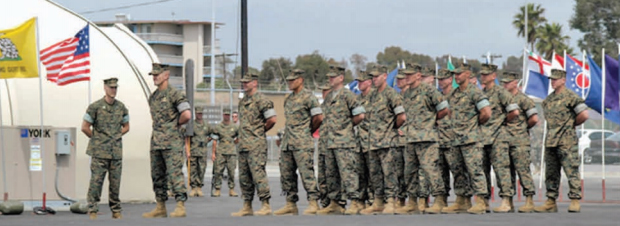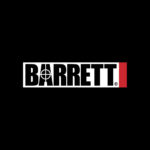The bulletin to stand up MCSOCOM Detachment One came just before the Marine Corps went full-swing into preparation for Operation Iraqi Freedom. This led to some speed bumps getting the unit actually stood up, as so many of the Corps’ resources were dedicated to the coming push to overthrow Saddam. The Command Element was given until 1 March, 2003 to report in, while the rest of the Marines and sailors in the Det had until 1 June. Given operational commitments in Iraq, many didn’t make it until after June 1st.
Col Robert Coates, the Detachment Commander, was one of the first to arrive on March 1st. In fact, being the commander of 1st Special Operations Training Group, he was really already there. Over the next several months the selected personnel began to arrive. While MSgt Troy Mitchell had outlined the billets to be filled, the Reconnaissance MOS monitor, MSgt James Rutan, had gone through the records and selected the Marines to fill those billets. All were experienced Recon Marines, many with nearly 20 years already in service. MSgt Rutan would be the Detachment’s acting Sergeant Major, being the senior enlisted Marine present.
Just about everything about the Det had to be built from scratch. While initial work was done out of 1st Special Operations Training Group’s headquarters, the new compound near the dive locker at Camp Del Mar, on the southwest corner of Camp Pendleton, had to be prepared with few personnel. The Det’s network specialist, Sgt Victor Guerra, had to do a great deal of the work himself, setting up not just the computer networks, but getting power and phone lines into the compound, as well as starting to set up the comm shop. Often Guerra had to deal with staff officers and senior NCOs who vastly outranked him, but Col Coates made it clear that Sgt Guerra spoke for him in such situations. Having the bulk of Camp Pendleton preoccupied with preparing to deploy to Iraq didn’t help things from a logistical standpoint either.
The personnel selected for the Det began to filter in. Lt Col Craig Kozeniesky was appointed the Executive Officer. MSgt Thomas Muratori came in as the Operations Chief. Capt Eric Thompson took command of the Reconnaissance Element, which was to be the core of the Detachment. Thompson had previously served at 1st Force Recon Company under Col Coates and Lt Col Kozeniesky. The Recon Element was set up as having four teams of six men each, along with the commander, platoon sergeant and corpsmen. MSgt Kieth Oakes took over as the platoon sergeant, with GySgt Terry Wyrick, GySgt Joseph Morrison, GySgt Charles Padilla, and GySgt John Dailey as team leaders. All were highly experienced Force Recon Marines. Gunny Morrison was in fact getting ready to retire, but put it off for the opportunity to serve in the Det.
Every one of the 30 men in the Recon Element had multiple deployments under their belts. Half were snipers, many had been instructors at the Mountain Warfare Training Center in Bridgeport, CA, or at one or the other of the SOTGs. The average age was over 30. The leadership were all graduates from Ranger School. And the selection process had been carefully gone through to ensure that each man was there to be a part of the team. That many Alpha personalities in one place could have had problems otherwise.
The Fires Element got started with Maj Wade Priddy reporting in as the Element leader on March 21st. Priddy was an artillery officer with experience in ANGLICO. The air officer, Major Thomas Dolan, was an AH-1 pilot who had been working for Col Coates at SOTG. GySgt Fidencio Villalobos, the Fires Chief, didn’t arrive until after the end of OIF I. He was a veteran forward observer, who had passed the Recon Indoc after the 1991 Gulf War, and gone to the 1st Surveillance, Reconnaissance, and Intelligence Group. From there, he had unofficially joined 1st Force Recon Company, living as a Recon Marine though the Company didn’t have a billet for an artillery forward observer.
The Intelligence Element was extremely important. Having a robust Intel capability was essential to allowing the Det to operate independently. Maj Gerald Carter, a mustang intel officer with experience in Radio Recon while he was enlisted, reported in as the Intel Officer on the 24th of March. His Intelligence Chief, MSgt Bret Hayes was a veteran of the Marine intelligence community, but had no experience with SOCOM. The Signals Intelligence section was headed up by GySgt Adam Toothaker, and the nine-man Radio Recon section by MSgt Hays Harrington.
The Detachment’s formal activation ceremony was performed at Camp Del Mar on June 20th, 2003. The Detachment’s full strength still had not arrived; some were en route from their home units, others were still en route from combat operations in Iraq.
Standing up the Detachment required building its store of equipment from the ground up. Given the timeline, and the specific requirements of the unit, that was quite difficult. A great deal of the early work was dedicated to getting the vast amount of specialized gear the detachment would need, both for the Reconnaissance Element and the Signals and Intelligence sections. Maj Carter had to fight to get a Trojan Spirit system—a command and control system that would allow for direct connections with national assets. GySgt Jaime Maldonado took over building the Motor T section, procuring 18 Interim Fast Attack Vehicles, or IFAVs.
Armament was another problem. The plan for the Det called for an M4 SOPMOD (Special Operations Modified) per man. When the unit armorer, GySgt Mark Kitashima, arrived, the armory consisted of “a lock, a chain, and an open cage.” They had no weapons at all. Kitashima immediately set about requisitioning weapons. Deciding that the standard MEU(SOC) pistol (a rebuilt M1911A1, some of them built on weapons dating back to WWII) wasn’t going to work, Kitashima ordered what would become known as the Interim Close Quarters Battle Pistol, a .45 caliber 1911 built by Kimber to Col Coates’ specifications. The unit also procured M249 SAWs, M240s, M2s, Mk 19s, M14 Designated Marksman Rifles, SR-25s, M40A1 bolt action sniper rifles, M82A3 .50 caliber anti-materiel rifles, and an experimental .408 Cheytac sniper rifle.
Given the timing of the unit’s formation, an ammunition allocation had not been built into the FY 2003 budget. The unit had no ammunition to train with. They had to find it where they could. However, there was plenty of work to be done first.
Already have an account? Sign In
Two ways to continue to read this article.
Subscribe
$1.99
every 4 weeks
- Unlimited access to all articles
- Support independent journalism
- Ad-free reading experience
Subscribe Now
Recurring Monthly. Cancel Anytime.
The compound had to be built, effectively from the asphalt up. Marines had to go to schools to fill in gaps in training. Col Coates sent anyone who needed an individual school while the initial standup process took place. Unit training was out of the question anyway, with personnel filtering in over a four-month time period.
There was also the operational relationship with SOCOM to be worked out. Under the Marine/SOCOM agreement, the Det fell operationally under SEAL Team One. There was some friction between both the Marines and the NSW command over just who was calling the shots as to how the new unit was to be tasked. At the time, there really was no resolution to anyone’s satisfaction. They didn’t even know where their operational destination was going to be, which made putting together the training plan difficult. But the new staff put together a general and all-encompassing a training schedule as they could.
Training Phase was to begin on July 1st, 2003.









